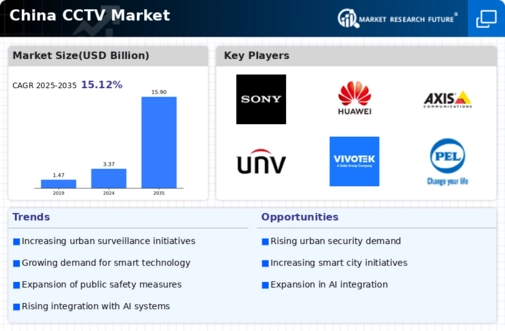Increasing Security Concerns
The rising concerns regarding public safety and security in urban areas are driving the demand for the cctv market in China. With urbanization accelerating, cities are experiencing higher crime rates, prompting local governments and businesses to invest in surveillance systems. In 2025, the market is projected to grow by approximately 15%, reflecting the urgency to enhance security measures. The cctv market is responding by offering advanced solutions that integrate artificial intelligence and analytics, enabling real-time monitoring and threat detection. This trend indicates a shift towards proactive security measures, as stakeholders recognize the importance of safeguarding public spaces and private properties. As a result, the cctv market is likely to see sustained growth fueled by these increasing security concerns.
Government Initiatives and Regulations
Government policies and regulations play a pivotal role in shaping the cctv market in China. The Chinese government has been actively promoting the installation of surveillance systems to enhance public safety and crime prevention. Recent initiatives have included funding for smart city projects that incorporate cctv technology. In 2025, it is estimated that government spending on security infrastructure will reach $10 billion, significantly impacting the cctv market. These regulations not only encourage the adoption of cctv systems but also set standards for their implementation, ensuring that the technology meets safety and privacy requirements. Consequently, the cctv market is likely to benefit from these supportive government measures, fostering a conducive environment for growth.
Technological Innovations in Surveillance
Technological advancements are revolutionizing the cctv market in China, with innovations such as high-definition cameras, cloud storage, and artificial intelligence. These technologies enhance the functionality and efficiency of surveillance systems, making them more appealing to consumers and businesses alike. In 2025, the market for AI-powered cctv solutions is expected to account for over 30% of total sales, indicating a significant shift towards smarter surveillance options. The cctv market is witnessing a surge in demand for integrated systems that offer features like facial recognition and motion detection. This trend suggests that as technology continues to evolve, the cctv market will likely expand, driven by the need for more sophisticated security solutions.
Integration with IoT and Smart Technologies
The integration of cctv systems with Internet of Things (IoT) devices and smart technologies is transforming the cctv market in China. This convergence allows for enhanced connectivity and data sharing, enabling more efficient monitoring and management of surveillance systems. In 2025, it is anticipated that IoT-enabled cctv solutions will represent a significant portion of the market, driven by the demand for smart home and smart city applications. The cctv market is likely to see increased collaboration between technology providers and manufacturers to develop integrated solutions that offer seamless user experiences. This trend suggests that as consumers become more tech-savvy, the demand for interconnected surveillance systems will continue to rise, further propelling the growth of the cctv market.
Rising Adoption in Retail and Commercial Sectors
The retail and commercial sectors in China are increasingly adopting cctv systems to enhance security and improve operational efficiency. With the growth of e-commerce and brick-and-mortar stores, businesses are recognizing the importance of surveillance in protecting assets and ensuring customer safety. In 2025, it is projected that the retail sector will account for approximately 25% of the cctv market, reflecting a growing trend towards comprehensive security solutions. The cctv market is responding by providing tailored solutions that meet the specific needs of retailers, such as loss prevention and customer behavior analysis. This rising adoption indicates a broader acceptance of surveillance technology as a critical component of business strategy.





















Leave a Comment